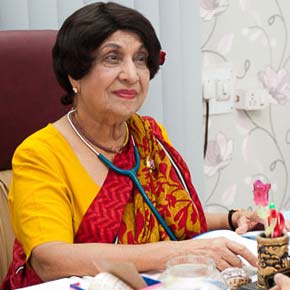
A young girl at school in Multan, whether it was chance or fate, we cannot say and little did the girl herself realize how that small act would affect the lives of countless people. From her days spent running around the Multan borstal, where her grandfather was the jailor, to her work in post-Partition refugee camps to set up a nursing home which would become an institution in Bangalore, Dr. (Mrs). Sita Bhateja has lived an extraordinary life and touched the lives of many thousand people.
As a granddaughter of Rai Saheb Gokal Chand and the daughter of Mohanlal Sachdev, she wanted for nothing. But simplicity defined her childhood. Exploring the grounds of Multan borstal, her playmates included the children of gardeners and labourers. It was early in her life she learned that compassion had its rewards.
Sita went to the jail school where the teachers were not the most inspiring. After the fourth standard, she moved to a government school at Miyanwali and was finally allowed to join the older children in the family at Lady McLagan School in Lahore.
Sita’s love for working with her hands saw her enjoying tailoring and machine embroidery. Somewhere during this time, Sita went for a holiday with her family to a hill station called Koh Mari off Rawalpindi. Here, she came across a Rose garden. And one of the great passions of her life was ignited. Soon she would collect different flowers. Her books were filled with pressings, which were sent to friends, and flowers would adorn her hair always.
At the age of fourteen, she had a vision, the girl who couldn’t wait to rush out of class, in that place stood a young woman who wished to serve mankind. Driven by her satvik belief, which dictated that she must serve humanity, she set her sights on doing medicine. But her father refused to let her study medicine. Her grandfather stepped in to help when she had decided to study medicine anyway.
During the partition, Sita and her family moved to India. They could manage to convince an army officer who was taking a truck to Lahore, to take them to Jammu. He agreed on the condition that they take nothing with them. In that instant, they abandoned all their belongings and climbed onto the truck to India. Eventually, they managed to cross over in January 1948. Her grandfather settled in McLeodganj and later the Dalai Lama occupied his house. Her father continued the jail service and was posted in Ferozepur.
Sita went to Bombay where she was admitted to KEM Hospital to continue her studies. After her graduation, she straight went to the refugee camps. Her first posting was in the refugee camps of Kurukshetra. After this, she moved to camps in Jol and Jammu. She worked in Cama Hospital and studied at Bombay University for her Post-graduation.
On July 11, 1953, Sita and Major Amrit Bhateja were married in a simple ceremony in Bombay. After spending a few years in Kirkee and a couple of years in MHOW, on 24th October 1957 she landed in Bangalore. She joined St. Martha’s hospital on the condition that she will take no salary. So, for the next 34 years, she would take only petrol money in the amount of Rs. 250/- per month. Dr Sita Bhateja started the obstetrics and Gynecology department in St. Martha’s hospital in a shed.
In 1968 Dr Sita Bhateja Nursing Home and Charitable trust were established. Sita donated 50% of her income to the trust, a practice that she would continue for her life.
Dr. (Mrs). Sita Bhateja became one of the prominent Gynecologists and director of several eponymous health-related centres including a 40-year-old clinic in her native Bengaluru, a hospital for the poor, an orphanage and a school for slum children. And she also gave some of her time to an old age home. She has received the Rashtriya Rattan award for her work in child welfare and, as an active Rotarian; she has likewise received “Governor’s Salute”. She was the past president of the Society of Obstetrics and Gynecology.
As well as her intense professional career, Dr Bhateja was one of the world’s foremost female philatelists, highly experienced in international exhibiting, and has won high-ranking medals beginning with her participation with Asiana ’77 in Bangalore, where she received an award for an exhibit of stamps of India. She was the Indian commissioner for the China 2009 International exhibition and her exhibit of India Classics was shown in the Court of Honour at INDIPEX-2011 in New Delhi.
In an interview with the newspaper, she recounted that philately as a hobby began in her childhood when she would get Rs. 10/- as pocket money, with which she could do much. But it was only after completing her studies that she enrolled with the Karnataka Philatelic Society and engaged herself with a more systematic collection of stamps.
Her collection, from the very beginning, was the stamps of India. Subsequently, she began to specialize in the stamps of pre-independent India and British stamps. She also collected stamps with medical themes from around the world. The scarcest – in fact, unique – item in her India collection is the 1854 bi-colour 4 anna stamp with the inverted head of the Queen, cut to square and one on the cover.
One piece of advice Dr Bhateja offers to philatelists: not to degenerate the hobby, one that is pursued with joy, to the level of awards. “Collecting stamps is for pleasure. Philately also offers so much knowledge. It is an encyclopedia of the history of one’s country,” said Dr Bhateja, for whom philately was an exhilarating hobby, which she got drowned in.
The Champion Ship Class philatelist’s research on each stamp meant that participation in an international exhibition took her two months, working through the night. And the three-time nominee for a Grand Prix added, “But I won’t need a cup of coffee to keep me awake!” She also helped kids and young collectors when they needed guidance on how to ready their exhibits.
We deeply mourn the death and pay our tribute to one of the great philatelists of India, Dr. (Mrs). Sita Bhateja, who passed away on 18th December 2018. She was always a strength for Inddak and Inddak will miss her services in future.
